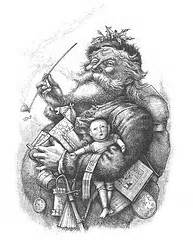'The Night Before Christmas'
|

|
|
Share This Page
|
|
|
|
|
|
|
Follow This Site

|
 |
|
|
|

|
"A Visit from St. Nicholas" is the official name of the extended poem more familiarly known as "The Night Before Christmas."
The poem, first published in the Troy (N.Y.) Sentinel in 1823, is commonly attributed to Clement Clarke Moore, an author, scholar, real estate developer, and pastor's son.
Moore is said to have come up for the idea of the poem while he was riding in a sleigh on Christmas Eve, on the way home to his family with a turkey for Christmas Day. One story has it that the sleigh driver was the inspiration for the portly, bearded image of Saint Nick that appears in the poem.
 Moore read his family the poem that night and then put it to rest. This was in 1822. A friend of the family got hold of a copy of the poem and sent it to the Sentinel, which published it two days before Christmas in 1823.
Moore read his family the poem that night and then put it to rest. This was in 1822. A friend of the family got hold of a copy of the poem and sent it to the Sentinel, which published it two days before Christmas in 1823.
Some historians question the veracity of Moore's claim of having written "A Visit from Saint Nicholas." Recent works have attributed the poem to someone else entirely.
Moore himself did not acknowledge authorship of the poem until he included it in a book of his poetry, in 1844. (He considered himself a "serious" poet and included the Christmas poem only at the express insistence of his children.) He never claimed copyright of "A Visit from Saint Nicholas." By the time that Moore died, though, in 1863, the poem was already famous. In the years since, the poem has appeared in part or as inspiration in films, television shows, songs, books, other poems, video games, and Christmas celebrations around the world.
The description of Santa Claus in "A Visit from St. Nicholas" has entered the popular lexicon, thanks in large part to illustrations done by an illustrator for the magazine Harper's Weekly, Thomas Nast. In a two-decade period, Nast created more than 2,000 illustrations of the Santa Claus story. Nast included now-familiar elements such as the reindeer and the chimney navigation.
Moore in that poem says that "St Nick" is in a miniature sleigh drawn by eight tiny reindeer. Moore even gives these reindeer names: Dasher, Dancer, Prancer, Vixen, Comet, Cupid, Donner, and Blitzen.
The names of the last two in the last have changed through the years, morphing between Dutch derivations, German derivations, and English derivatives. The Dutch words for thunder and lightning were "Dunder" and "Blixem." The German equivalents were "Donder" and "Blitzen."
Direct quotes from the poem are very familiar to celebrants of Christmas everywhere:
- 'Twas the night before Christmas, when all through the house. Not a creature was stirring, not even a mouse.
- The children were nestled all snug in their beds, while visions of sugar plums danced in their heads.
- When, what to my wondering eyes should appear, but a minature sleigh, and eight tiny rein-deer.
- He had a broad face, and a little round belly that shook when he laughed, like a bowl full of jelly.
- He was chubby and plump, a right jolly old elf.
- Merry Christmas to all, and to all a good night.